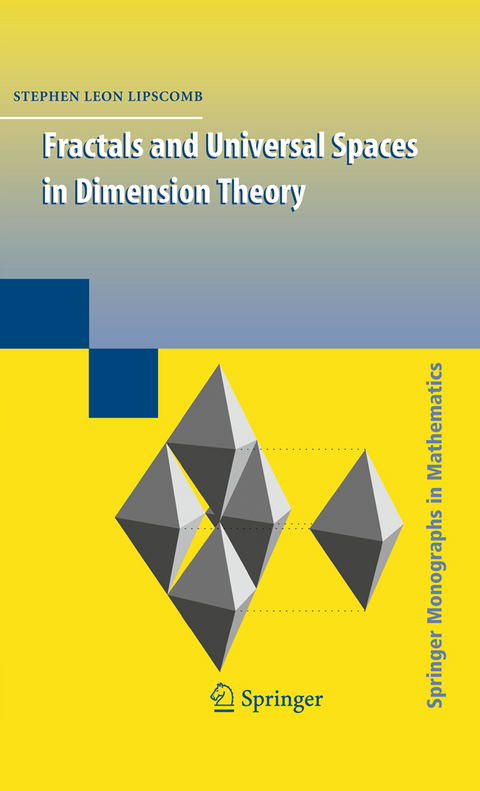
Fractals and Universal Spaces in Dimension Theory
Seiten
2010
|
Softcover reprint of hardcover 1st ed. 2009
Springer-Verlag New York Inc.
978-1-4419-2751-4 (ISBN)
Springer-Verlag New York Inc.
978-1-4419-2751-4 (ISBN)
For metric spaces the quest for universal spaces in dimension theory spanned a century of research, which breaks into two periods: the classical (separable metric) and the modern (not necessarily separable metric). This book details the modern theory.
Historically, for metric spaces the quest for universal spaces in dimension theory spanned approximately a century of mathematical research. The history breaks naturally into two periods - the classical (separable metric) and the modern (not-necessarily separable metric).
The classical theory is now well documented in several books. This monograph is the first book to unify the modern theory from 1960-2007. Like the classical theory, the modern theory fundamentally involves the unit interval.
Unique features include:
* The use of graphics to illustrate the fractal view of these spaces;
* Lucid coverage of a range of topics including point-set topology and mapping theory, fractal geometry, and algebraic topology;
* A final chapter contains surveys and provides historical context for related research that includes other imbedding theorems, graph theory, and closed imbeddings;
* Each chapter contains a comment section that provides historical context with references that serve as a bridge to the literature.
This monograph will be useful to topologists, to mathematicians working in fractal geometry, and to historians of mathematics. Being the first monograph to focus on the connection between generalized fractals and universal spaces in dimension theory, it will be a natural text for graduate seminars or self-study - the interested reader will find many relevant open problems which will create further research into these topics.
Historically, for metric spaces the quest for universal spaces in dimension theory spanned approximately a century of mathematical research. The history breaks naturally into two periods - the classical (separable metric) and the modern (not-necessarily separable metric).
The classical theory is now well documented in several books. This monograph is the first book to unify the modern theory from 1960-2007. Like the classical theory, the modern theory fundamentally involves the unit interval.
Unique features include:
* The use of graphics to illustrate the fractal view of these spaces;
* Lucid coverage of a range of topics including point-set topology and mapping theory, fractal geometry, and algebraic topology;
* A final chapter contains surveys and provides historical context for related research that includes other imbedding theorems, graph theory, and closed imbeddings;
* Each chapter contains a comment section that provides historical context with references that serve as a bridge to the literature.
This monograph will be useful to topologists, to mathematicians working in fractal geometry, and to historians of mathematics. Being the first monograph to focus on the connection between generalized fractals and universal spaces in dimension theory, it will be a natural text for graduate seminars or self-study - the interested reader will find many relevant open problems which will create further research into these topics.
Construction of =.- Self-Similarity and for Finite.- No-Carry Property of.- Imbedding in Hilbert Space.- Infinite IFS with Attractor.- Dimension Zero.- Decompositions.- The Imbedding Theorem.- Minimal-Exponent Question.- The Imbedding Theorem.- 1992#x2013;2007 -Related Research.- Isotopy Moves into 3-Space.- From 2-Web IFS to 2-Simplex IFS 2-Space and the 1-Sphere.- From 3-Web IFS to 3-Simplex IFS 3-Space and the 2-Sphere.
| Reihe/Serie | Springer Monographs in Mathematics |
|---|---|
| Zusatzinfo | 15 Illustrations, color; 76 Illustrations, black and white; XVIII, 242 p. 91 illus., 15 illus. in color. |
| Verlagsort | New York, NY |
| Sprache | englisch |
| Maße | 155 x 235 mm |
| Themenwelt | Mathematik / Informatik ► Mathematik ► Analysis |
| Mathematik / Informatik ► Mathematik ► Angewandte Mathematik | |
| Mathematik / Informatik ► Mathematik ► Geometrie / Topologie | |
| ISBN-10 | 1-4419-2751-4 / 1441927514 |
| ISBN-13 | 978-1-4419-2751-4 / 9781441927514 |
| Zustand | Neuware |
| Haben Sie eine Frage zum Produkt? |
Mehr entdecken
aus dem Bereich
aus dem Bereich
Buch | Softcover (2024)
De Gruyter Oldenbourg (Verlag)
59,95 €


